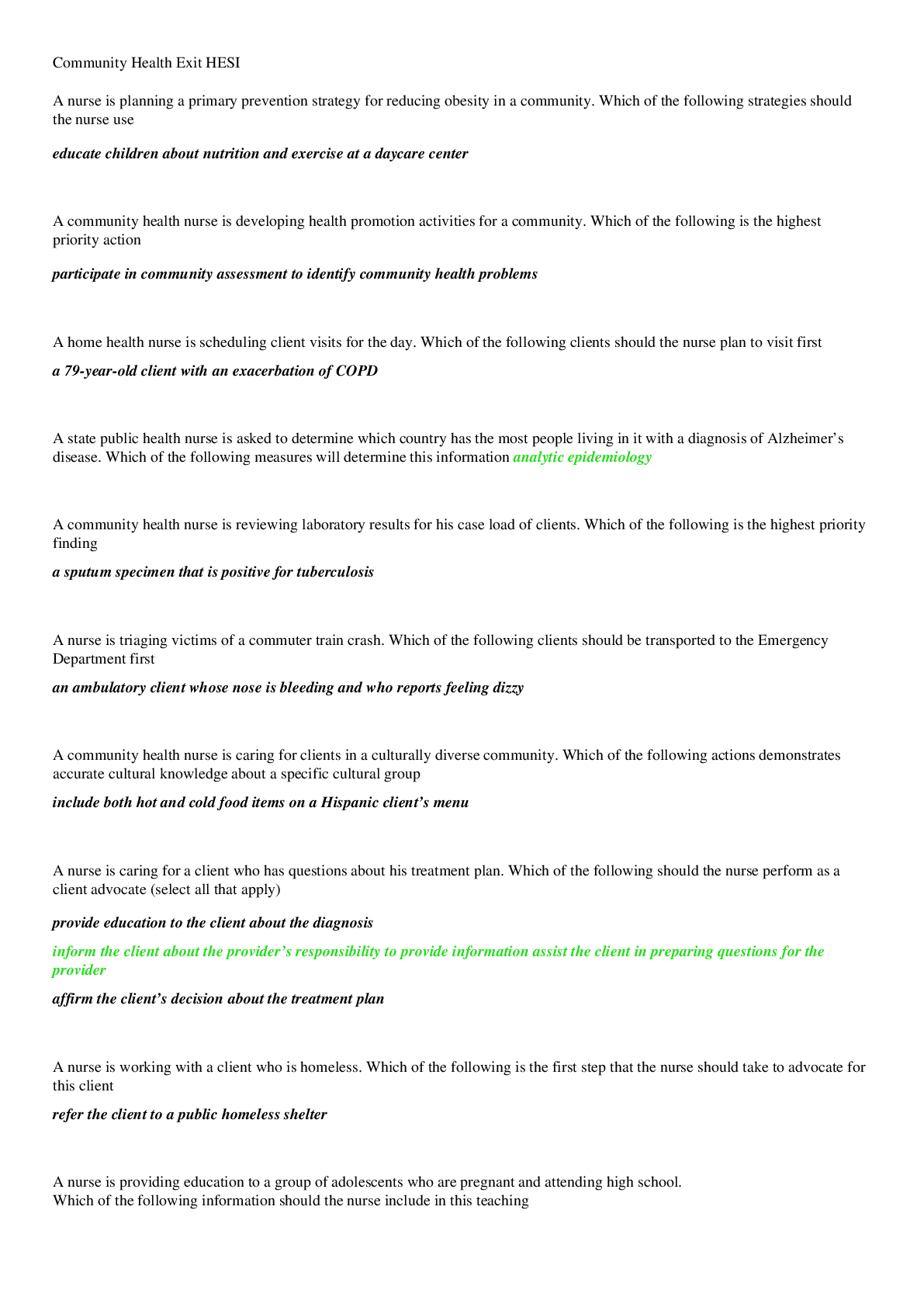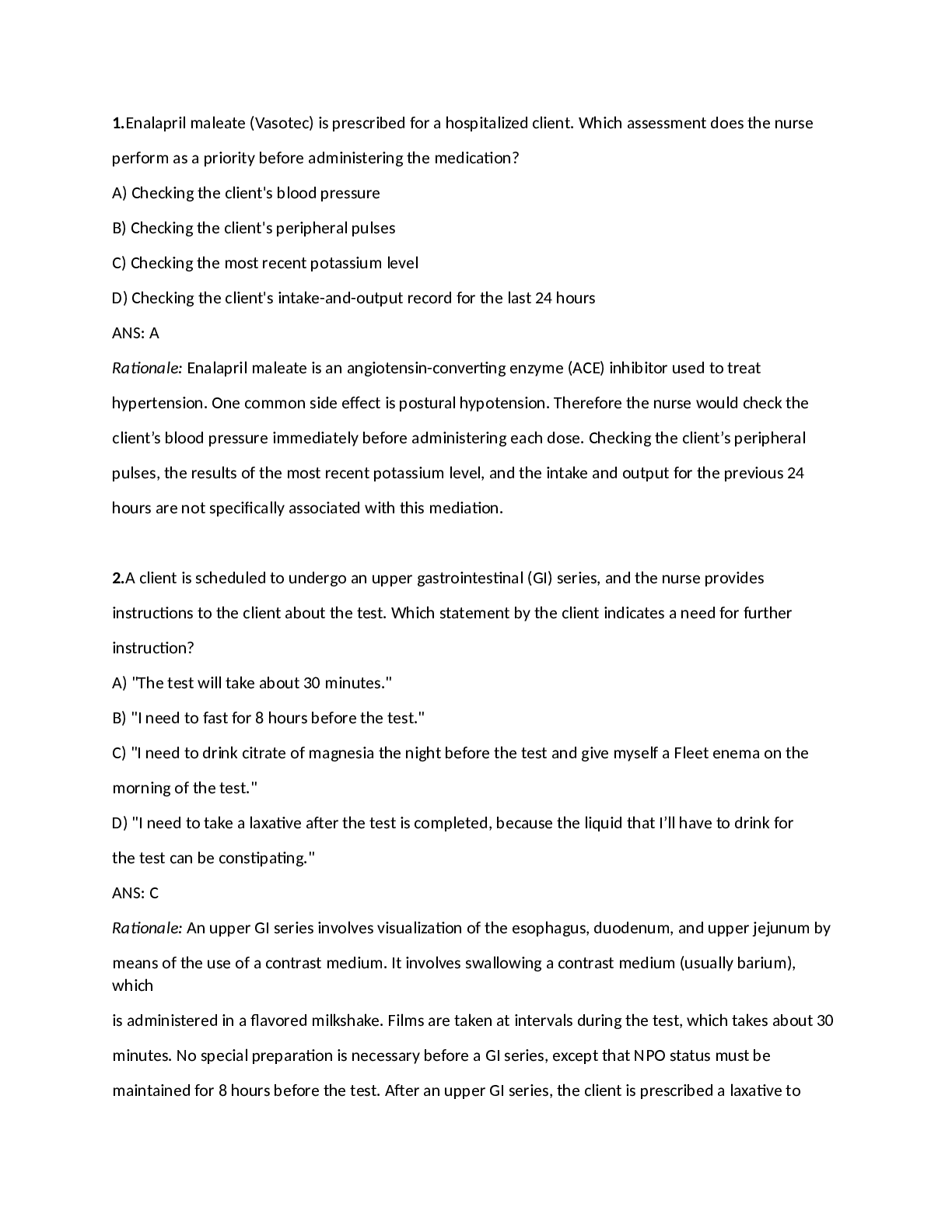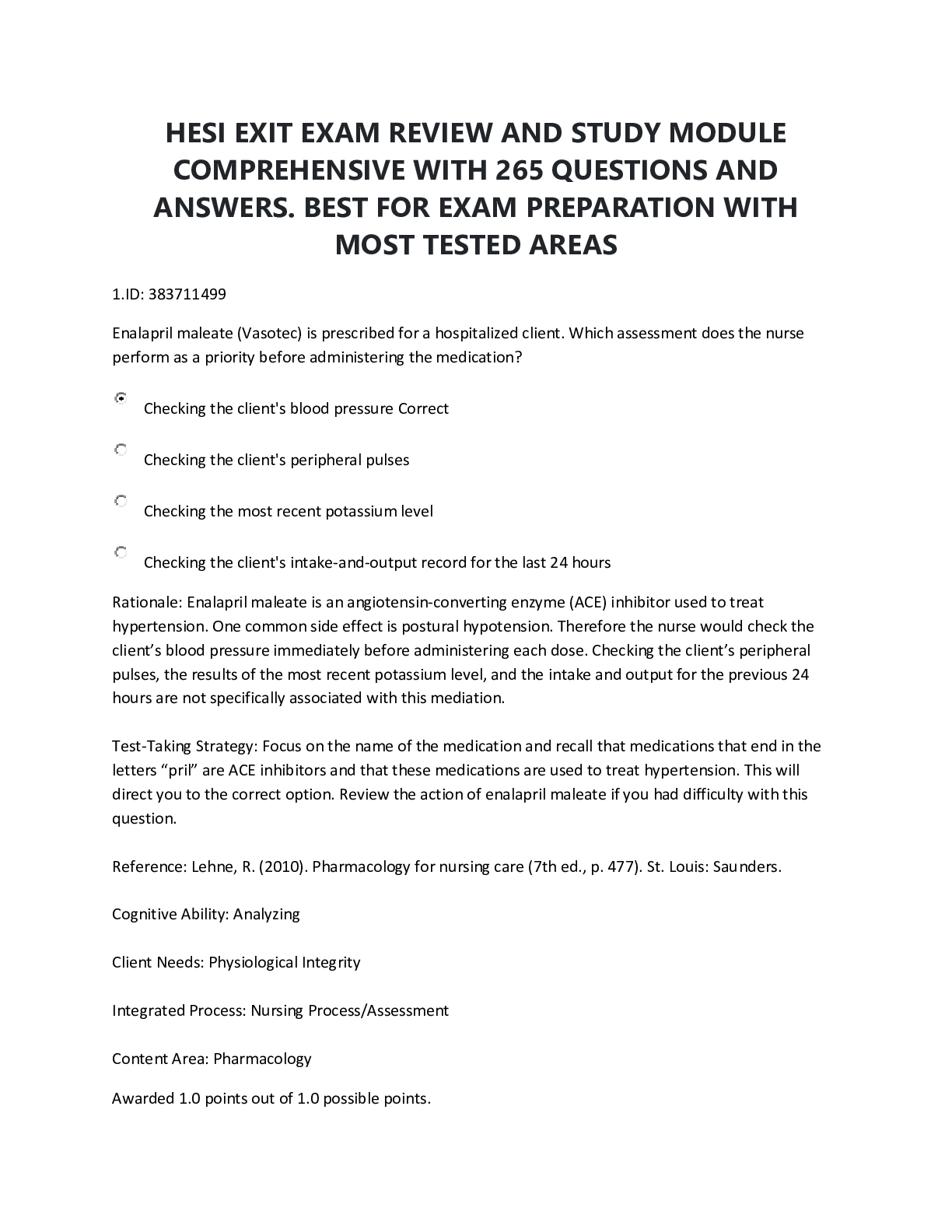*NURSING > HESI > HESI Fundamentals 12 Latest Versions Verified Questions and Answers Best Document for Exam Preparati (All)
HESI Fundamentals 12 Latest Versions Verified Questions and Answers Best Document for Exam Preparation 100 % Satisfaction Guaranteed
Document Content and Description Below
HESI Fundamentals 12 Latest Versions Verified Questions and Answers Best Document for Exam Preparation 100 % Satisfaction Guaranteed 1. A nurse is collecting data from a client who takes haloperi... dol to treat schizophrenia. Which of the following findings should the nurse document as extrapyramidal symptoms (EPSs)? (Select all that apply.) a. Orthostatic hypotension b. Tremors c. Acute dystonia d. Decreased level of consciousness e. Restlessness 2. A nurse is teaching a client who has a new prescription for oxybutynin about managing the medication‟s anticholinergic effects. Which of the following instructions should the nurse include? (Select all that apply.) a. Take sips of water frequently. b. Wear sunglasses when outdoors in sunlight. c. Use a soft toothbrush when brushing teeth. d. Take the medication with an antacid.e. Urinate prior to taking the medication. 3. A nurse is reviewing a client‟s medications. They include cimetidine and imipramine. Knowing that cimetidine decreases the metabolism of imipramine, the nurse should identify that this combination is likely to result in which of the following effects? a. Decreased therapeutic effects of cimetidine b. Increased risk of imipramine toxicity c. Decreased risk of adverse effects of cimetidine d. Increased therapeutic effects of imipramine 4. A nurse in an outpatient clinic is caring for a client who has a new prescription for an antihypertensive medication. Which of the following instructions should the nurse give the client? a. “Get up and change positions slowly.” b. “Avoid eating aged cheese and smoked meat.” c. “Report any usual bruising or bleeding to the doctor immediately.” d. “Eat the same amount of foods that contain vitamin K every day.” 5. A nurse in an outpatient surgical center is admitting a client for a laparoscopic procedure. The client has a prescription for preoperative diazepam. Prior to administering the medication, which of the following actions is the nurse‟s priority? a. Teaching the client about the purpose of the medication b. Giving the medication at the administration time the provider prescribed c. Identifying the client‟s medication allergies d. Documenting the client‟s anxiety level Chapter 51 1. To promote adherence with medication self-administration, a nurse is making recommendations for an older adult client. Which of the following instructions should the nurse include? (Select all that apply.) a. Adjust dosages according to daily weight. b. Place pills in daily pill holders. c. Ask for liquid forms if the client has difficulty swallowing pills. d. Ask a relative to assist periodically. e. Request child-resistant caps on medication containers.2. A client in a provider‟s office tells the nurse that “I fast for several days each week to help control my weight.” The client takes several medications for various chronic issues. The nurse should explain to the client that which of the following mechanisms that results from fasting puts her at risk for medication toxicity? a. Increasing the metabolism of the medications over time b. Increasing the protein-binding response c. Increasing medications‟ transit time through the intestines d. Decreasing the excretion of medications 3. A nurse is preparing medications for a preschooler. Which of the following factors should the nurse identify as altering how a medication affects children? (Select all that apply.) a. Increased gastric acid production b. Immature liver c. Higher body water content d. Increased absorption of topical medications e. Increased gastric emptying time 4. A nurse is teaching a client who is lactating about taking medications. Which of the following actions should the nurse recommend to minimize in the entry of medication into breast milk? a. Drink 8 oz of milk with each dose of medication. b. Use medications that have an extended half-life. c. Take each dose right after breastfeeding. d. Pump breast milk and freeze it prior to feeding to the newborn. 5. A nurse in an outpatient clinic is teaching a client who is in the first trimester of pregnancy. Which of the following statements should the nurse make? a. “You will need to get a rubella immunization if you haven‟t had one prior to pregnancy.” b. “You can safely take over-the-counter medications.” c. “You should avoid any vitamin preparations containing iron.” d. “Your provider can prescribe medication for nausea if you need it.” Chapter 52 1. A nurse is reviewing the medical record of a client who has a blood glucose of 260 mg/dL and no documented history of diabetes mellitus. Which of the following types of medications can cause hyperglycemia as an adverse effect? (Select all that apply.) a. Diureticsb. Corticosteroids c. Oral anticoagulants d. Opioid analgesics e. Antipsychotics 2. A nurse teaching a client how to check blood glucose levels. The nurse should include which of the following instructions about transferring blood onto the reagent portion of the test strip? a. Smear the blood onto the strip. b. Squeeze the blood onto the strip. c. Touch the puncture to stimulate bleeding. d. Hold the test strip next to the blood on the fingertip. 3. A nurse attempting to collect a capillary blood specimen via finger stick for blood glucose monitoring is unable to obtain an adequate drop of blood for the reagent strip. Which of the following actions should the nurse take first? a. Puncture another finger to obtain a capillary specimen. b. Test the urine with a urine reagent strip. c. Wrap the hand in a warm, moist cloth. d. Perform a venipuncture to obtain a venous sample. 4. A nurse is teaching self-monitoring of blood glucose (SMBG) to a client who has diabetes mellitus. Which of the following instructions should the nurse include? (Select all that apply.) a. Perform SMBG once daily at bedtime. b. Wipe the hand with an alcohol swab. c. Hold the hand in a dependent position prior to the puncture. d. Place the puncturing device perpendicular to the site. e. Prick the outer edge of the fingertip for the blood sample Chapter 53 1. A nurse is assessing a client who has an acute respiratory infection, increasing the risk for hypoxemia. Which of the following findings are early indications that should alert the nurse that the client is developing hypoxia? (Select all that apply.) a. Restlessness b. Tachypnea c. Bradycardiad. Confusion e. Hypertension 2. A provider is discharging a client who has a prescription for home oxygen therapy via nasal cannula. Client and family teaching by the nurse should include which of the following instructions? (Select all that apply.) a. Apply petroleum jelly around and inside the nares. b. Remove the nasal cannula during mealtimes. c. Check the position of the cannula frequently. d. Report any nausea or difficulty breathing. e. Post “No Smoking” signs in prominent locations. 3. A nurse is caring for a client who is having difficulty breathing. The client is lying in bed and is already receiving oxygen therapy via nasal cannula. Which of the following interventions is the nurse‟s priority? a. Increase the oxygen flow. b. Assist the client to Fowler‟s position. c. Promote removal of pulmonary secretions. d. Obtain a specimen for arterial blood gases. 4. A nurse is preparing to perform endotracheal suctioning for a client. The nurse should follow which of the following guidelines? (Select all that apply.) a. Apply suction while withdrawing the catheter. b. Perform suctioning on a routine basis every 2 to 3 hr. c. Maintain medical asepsis during suctioning. d. Use a new catheter for each suctioning attempt. e. Apply suction for 10 to 15 seconds. 5. A nurse is caring for a client who has a tracheostomy. Which of the following actions should the nurse take when providing tracheostomy care? (Select all that apply.) a. Apply the oxygen source loosely if the SpO2 decreases during the procedure. b. Use surgical asepsis to remove and clean the inner cannula. c. Clean the outer cannula surfaces in a circular motion from the stoma site outward. d. Replace the tracheostomy ties with new ties. e. Cut a slit in gauze squares to place beneath the tube holder. Chapter 541. A nurse is delivering an enteral feeding to a client who has an NG tube in place for intermittent feedings. When the nurse pours water into the syringe after the formula drains from the syringe, the client asks the nurse why the water is necessary. Which of the following responses should the nurse make? a. “Water helps clear the tube so it doesn‟t get clogged.” b. “Flushing helps make sure the tube stays in place.” c. “This will help you get enough fluids.” d. “Adding water makes the formula less concentrated.” 2. A nurse is caring for a client who is receiving continuous enteral feedings. Which of the following nursing interventions is the highest priority when the nurse suspects aspiration of the feeding? a. Auscultate breath sounds. b. Stop the feeding. c. Obtain a chest x-ray. d. Initiate oxygen therapy. 3. A nurse is preparing to instill an enteral feeding for a client who has an NG tube in place. Which of the following actions is the nurse‟s highest assessment priority before performing this procedure? a. Check how long the feeding container has been open. b. Verify the placement of the NG tube. c. Confirm that the client does not have diarrhea. d. Make sure the client is alert and oriented. 4. A nurse is caring for a client in a long-term care facility who is receiving enteral feedings via an NG tube. Which of the following actions should the nurse complete prior to administering the tube feeding? (Select all that apply.) a. Auscultate bowel sounds. b. Assist the client to an upright position. c. Test the pH of gastric aspirate. d. Warm the formula to body temperature. e. Discard any residual gastric contents. 5. A nurse is preparing to insert an NG tube for a client who requires gastric decompression. Which of the following actions should the nurse perform before beginning the procedure? (Select all that apply.) a. Review a signal the client can use if feeling any distress.b. Lay a towel across the client‟s chest. c. Administer oral pain medication. d. Obtain a Dobhoff tube for insertion. e. Have a petroleum-based lubricant available. Chapter 55 1. A nurse is caring for a client who is 2 days postoperative following an appendectomy and has type I diabetes mellitus. Their Hgb is 12 g/dL and BMI is 17.1. The incision is approximated and free of redness, with scant serous drainage on the dressing. The nurse should recognize that the client has which of the following risk factors for impaired wound healing? (Select all that apply.) a. Extremes in age b. Chronic illness c. Low hemoglobin d. Malnutrition e. Poor wound care 2. A nurse is collecting data from a client who is 5 days postoperative following abdominal surgery. The surgeon suspects an incisional wound infection and has prescribed antibiotic therapy for the nurse to initiate after collecting wound and blood specimens for culture and sensitivity. Which of the following findings should the nurse expect? (Select all that apply.) a. Increase in incisional pain b. Fever and chills c. Reddened wound edges d. Increase in serosanguineous drainage e. Decrease in thirst 3. A nurse educator is reviewing the wound healing process with a group of nurses. The nurse educator should include in the information which of the following alterations for wound healing by secondary intention? (Select all that apply.) a. Stage 3 pressure injury b. Sutured surgical incision c. Casted bone fracture d. Laceration sealed with adhesive e. Open burn area4. A client who had abdominal surgery 24 hr ago suddenly reports a pulling sensation and pain in their surgical incision. The nurse checks the surgical wound and finds it separated with viscera protruding. Which of the following actions should the nurse take? (Select all that apply.) a. Cover the area with saline-soaked sterile dressings. b. Apply an abdominal binder snugly around the abdomen. c. Use sterile gauze to apply gentle pressure to the exposed tissues. d. Position the client supine with the hips and knees bent. e. Offer the client a warm beverage (herbal tea). 5. A nurse is caring for a client who is at risk for developing pressure injury. Which of the following interventions should the nurse use to help maintain the integrity of the client‟s skin? (Select all that apply.) a. Keep the head of the bed elevated 30°. b. Massage the client‟s bony prominences frequently. c. Apply cornstarch liberally to the skin after bathing. d. Have the client sit on a gel cushion when in a chair. e. Reposition the client at least every 3 hr while in bed. Chapter 56 1. A nurse is discussing direct and indirect contact modes of transmission of infection at a staff education session. Which of the following incidents should the nurse include as examples of the direct mode of transmission? (Select all that apply.) a. Blood spurting from an arterial wound splashes into a nurse‟s eye. b. A nurse has a needlestick injury. c. A mosquito bites a hiker in the woods. d. A nurse finds a hole in their glove while handling a soiled dressing. e. A person fails to wash their hands after using the bathroom and touches a client. 2. A nurse in a residential care facility is assessing an older adult client. Which of the following findings should the nurse identify as atypical indications of infection in this client? (Select all that apply.) a. Urinary incontinence b. Malaise c. Acute confusion d. Fever e. Agitation3. A nurse is preparing to admit a client who is suspected to have pulmonary tuberculosis. Which of the following actions should the nurse plan to perform first? a. Implement airborne precautions. b. Obtain a sputum culture. c. Administer antituberculosis medications. d. Recommend a screening test for family members. 4. A nurse in a primary care clinic is assessing a client who has a history of herpes zoster. Which of the following findings suggests that the client has postherpetic neuralgia? a. Linear clusters of vesicles on the right shoulder b. Purulent drainage from both eyes c. Decreased white blood cell count d. Report of continued pain following resolution of the rash 5. A charge nurse is teaching a newly licensed nurse about the care of a client who has methicillinresistant Staphylococcus aureus (MRSA). Which of the following statements should the charge nurse identify as an indication that the newly licensed nurse understands the teaching? a. “I should obtain a specimen for culture and sensitivity after the first dose of an antimicrobial.” b. “MRSA is usually resistant to vancomycin, so another antimicrobial will be prescribed.” c. “I will protect others from exposure when I transport the client outside the room.” d. “To decrease resistance, antimicrobial therapy is discontinued when the client is no longer febrile.” Chapter 57 1. A nurse is performing an admission assessment on a client who has hypovolemia due to vomiting and diarrhea. The nurse should expect which of the following findings? (Select all that apply.) a. Distended neck veins b. Hyperthermia c. Tachycardia d. Syncope e. Decreased skin turgor2. A nurse on a medical-surgical unit is caring for a group of clients. The nurse should identify that which of the following clients is at risk for hypovolemia? a. A client who has nasogastric suctioning b. A client who has chronic constipation c. A client who has syndrome of inappropriate antidiuretic hormone d. A client who took an toxic dose of sodium bicarbonate antacids 3. A nurse is reviewing the laboratory test results for a client who has an elevated temperature. The nurse should identify which of the following findings is a manifestation of dehydration? (Select all that apply.) a. Hct 55% b. Blood osmolarity 260 mOsm/kg c. Blood sodium 150 mEq/L d. Urine specific gravity 1.035 e. Blood creatinine 0.6 mg/dL 4. A nurse on a medical-surgical unit is caring for a group of clients. For which of the following clients should the nurse expect a prescription for fluid restriction? a. A client who has a new diagnosis of adrenal insufficiency b. A client who has heart failure c. A client who is receiving treatment for diabetic ketoacidosis d. A client who has abdominal ascites 5. A nurse is planning care for a client who has dehydration. Which of the following actions should the nurse include? a. Administer antihypertensive on schedule. b. Check the client‟s weight each morning. c. Notify the provider of a urine output greater than 30 mL/hr. d. Encourage independent ambulation four times a day. Chapter 58 1. A nurse is planning care for a client who has hypernatremia. Which of the following actions should the nurse include in the plan of care? a. Infuse hypotonic IV fluids. b. Implement a fluid restriction.c. Increase sodium intake. d. Administer sodium polystyrene sulfonate. 2. A nurse is reviewing the medical record of a client who has hypocalcemia. The nurse should identify which of the following findings as a risk factor for the development of this electrolyte imbalance? a. Crohn‟s disease b. Postoperative following appendectomy c. History of bone cancer d. Hyperthyroidism 3. A nurse receives a laboratory report for a client indicating a potassium level of 5.2 mEq/L. When notifying the provider, the nurse should expect which of the following actions? a. Starting an IV infusion of 0.9% sodium chloride b. Consulting with dietitian to increase intake of potassium c. Initiating continuous cardiac monitoring d. Preparing the client for gastric lavage 4. A nurse is collecting data from a client who has hypercalcemia as a result of long-term use of glucocorticoids. Which of the following findings should the nurse expect? (Select all that apply.) a. Hyperreflexia b. Confusion c. Positive Chvostek‟s sign d. Bone pain e. Nausea and vomiting [Show More]
Last updated: 1 year ago
Preview 1 out of 249 pages
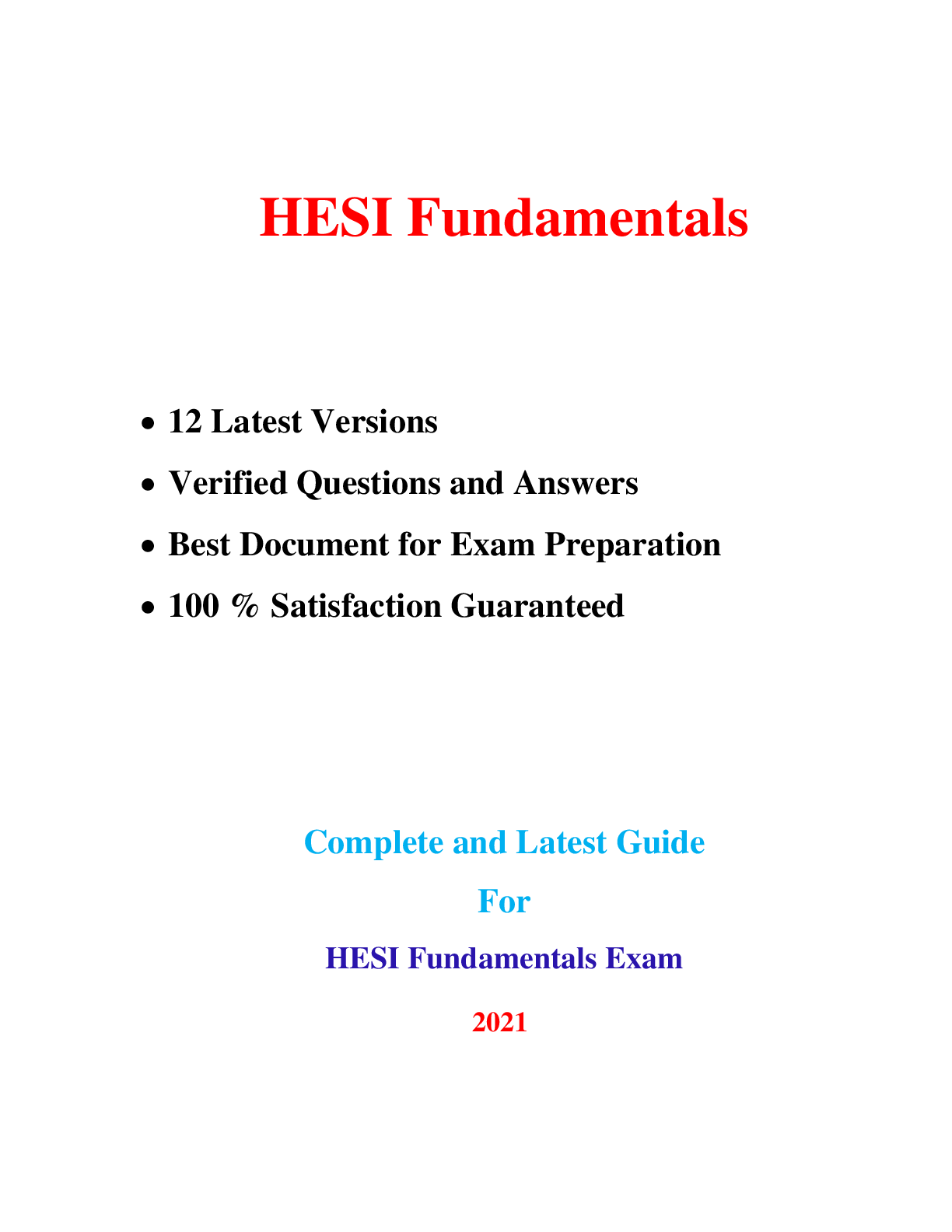
Reviews( 0 )
Document information
Connected school, study & course
About the document
Uploaded On
Nov 22, 2022
Number of pages
249
Written in
Additional information
This document has been written for:
Uploaded
Nov 22, 2022
Downloads
0
Views
32



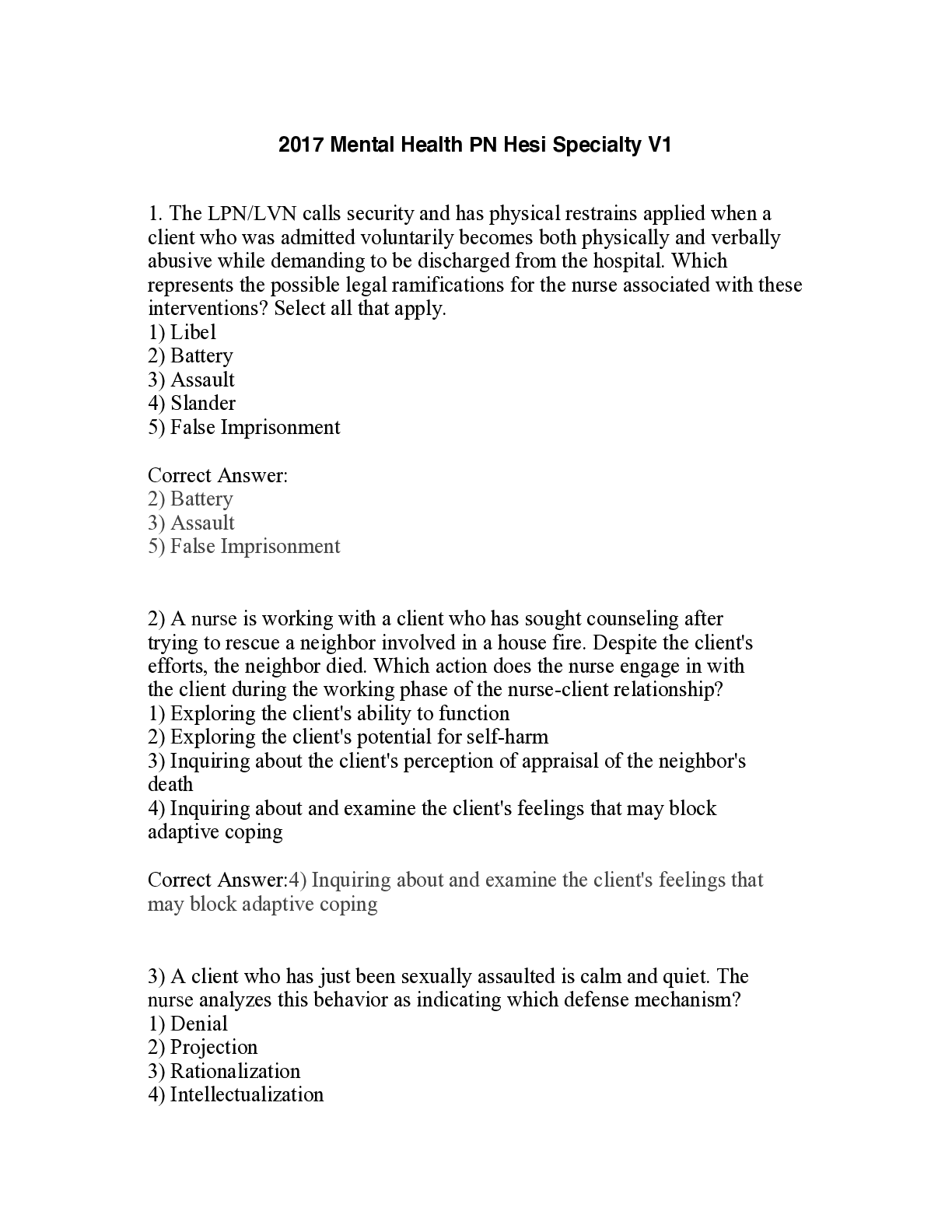




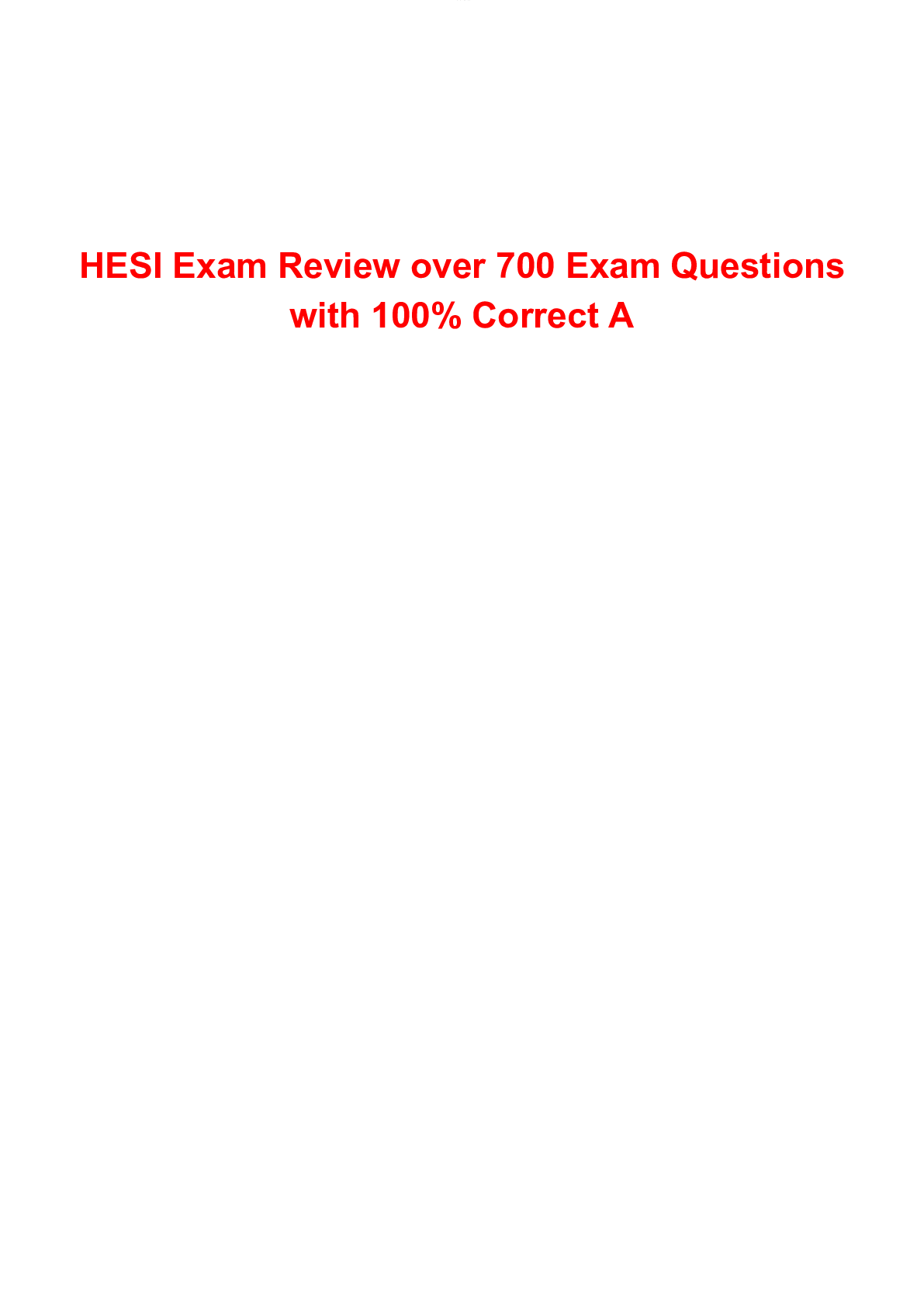

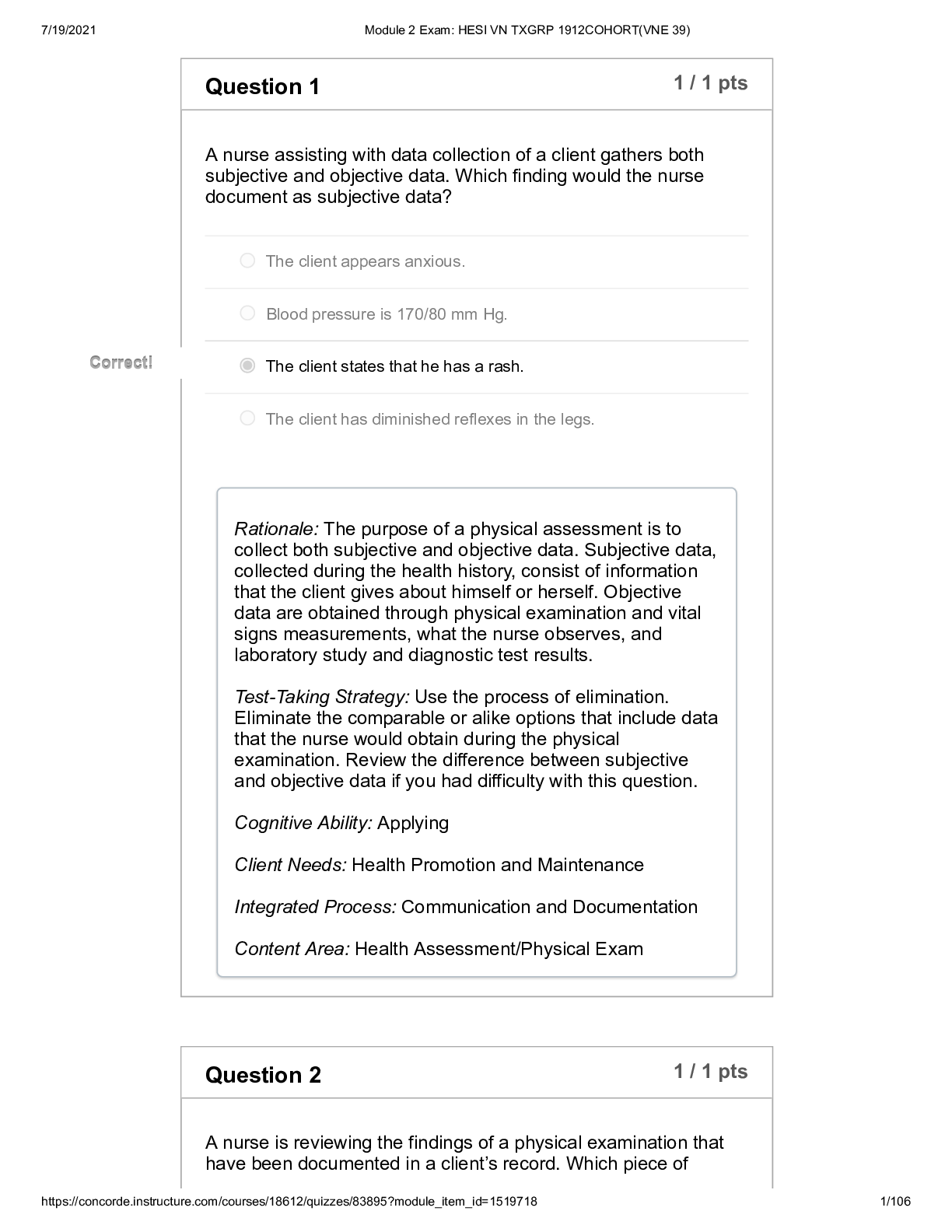
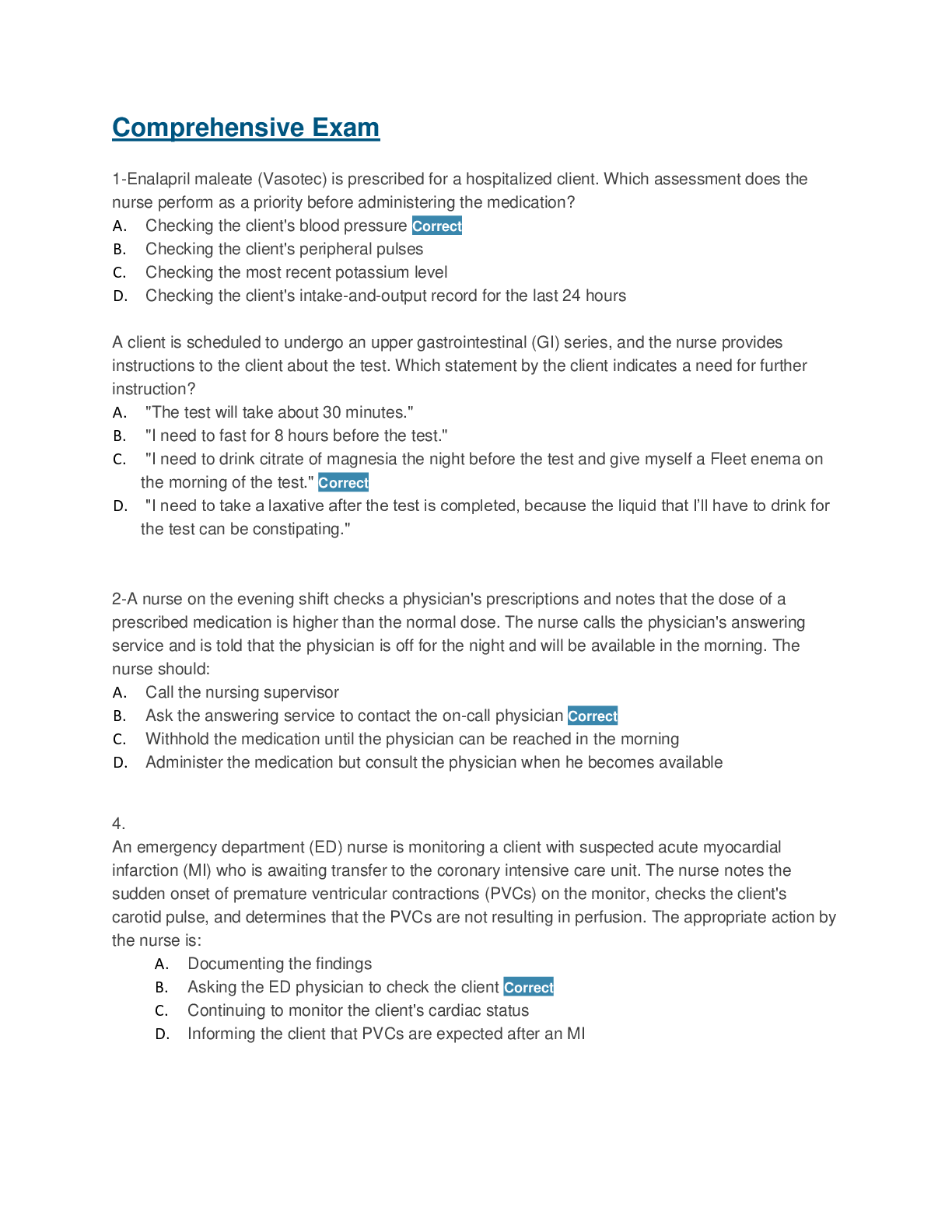
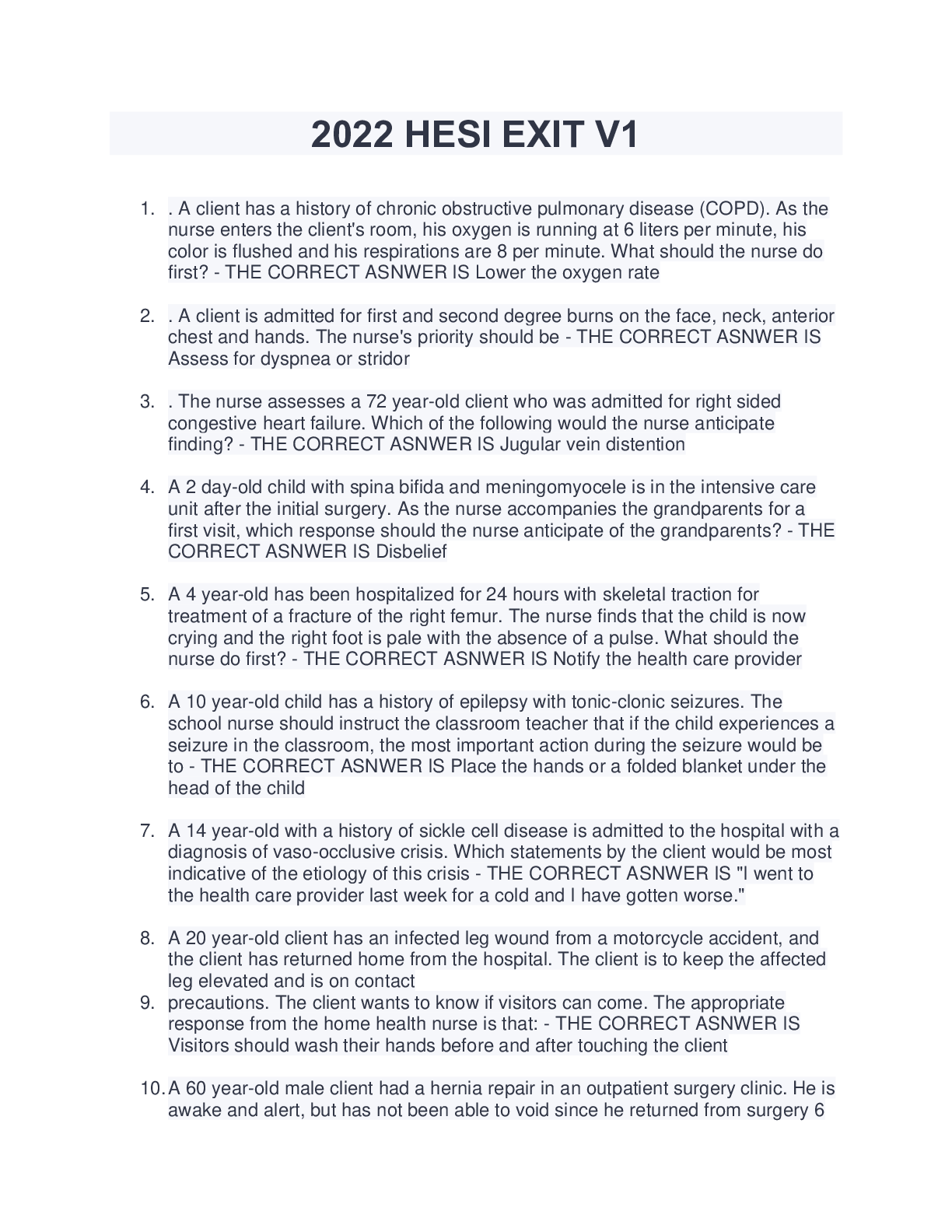
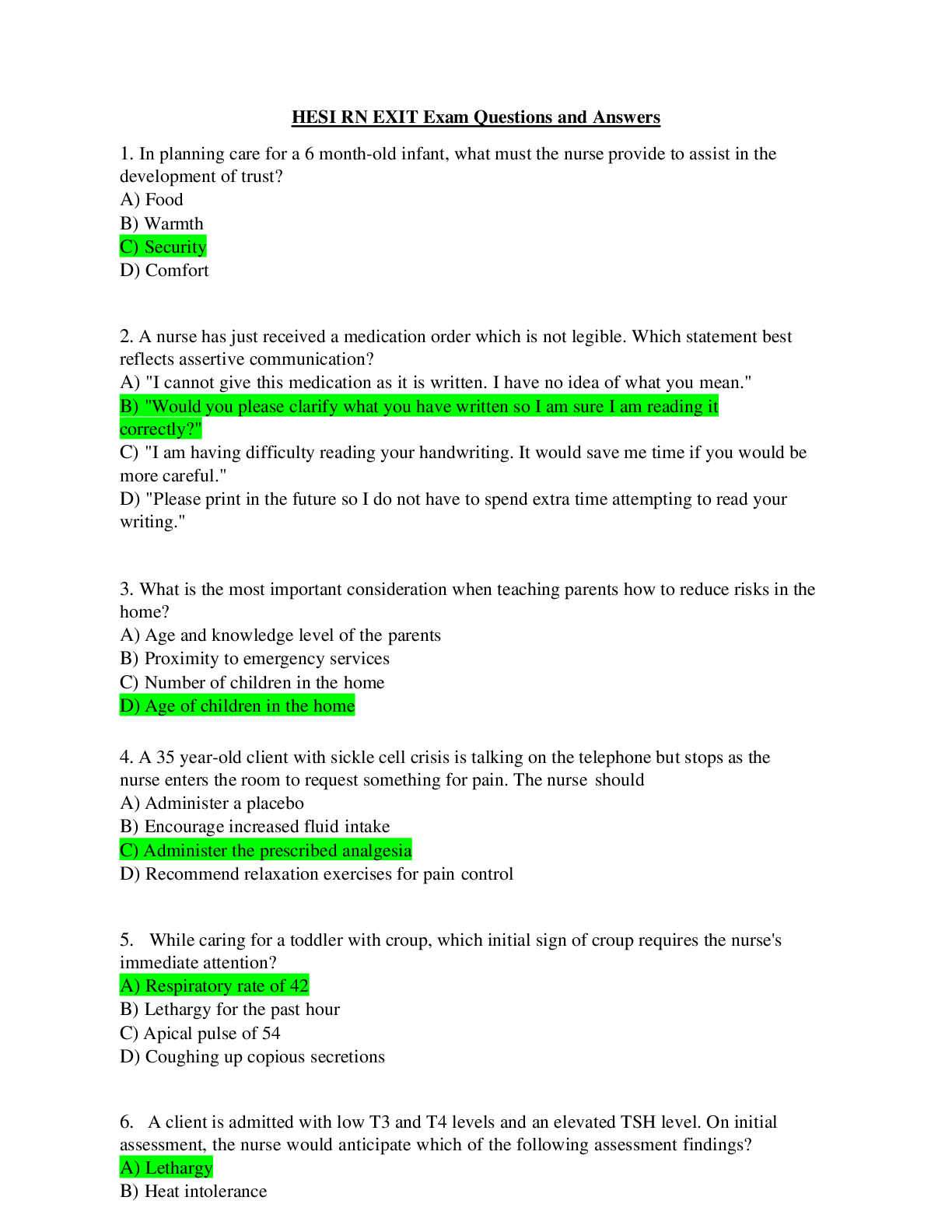

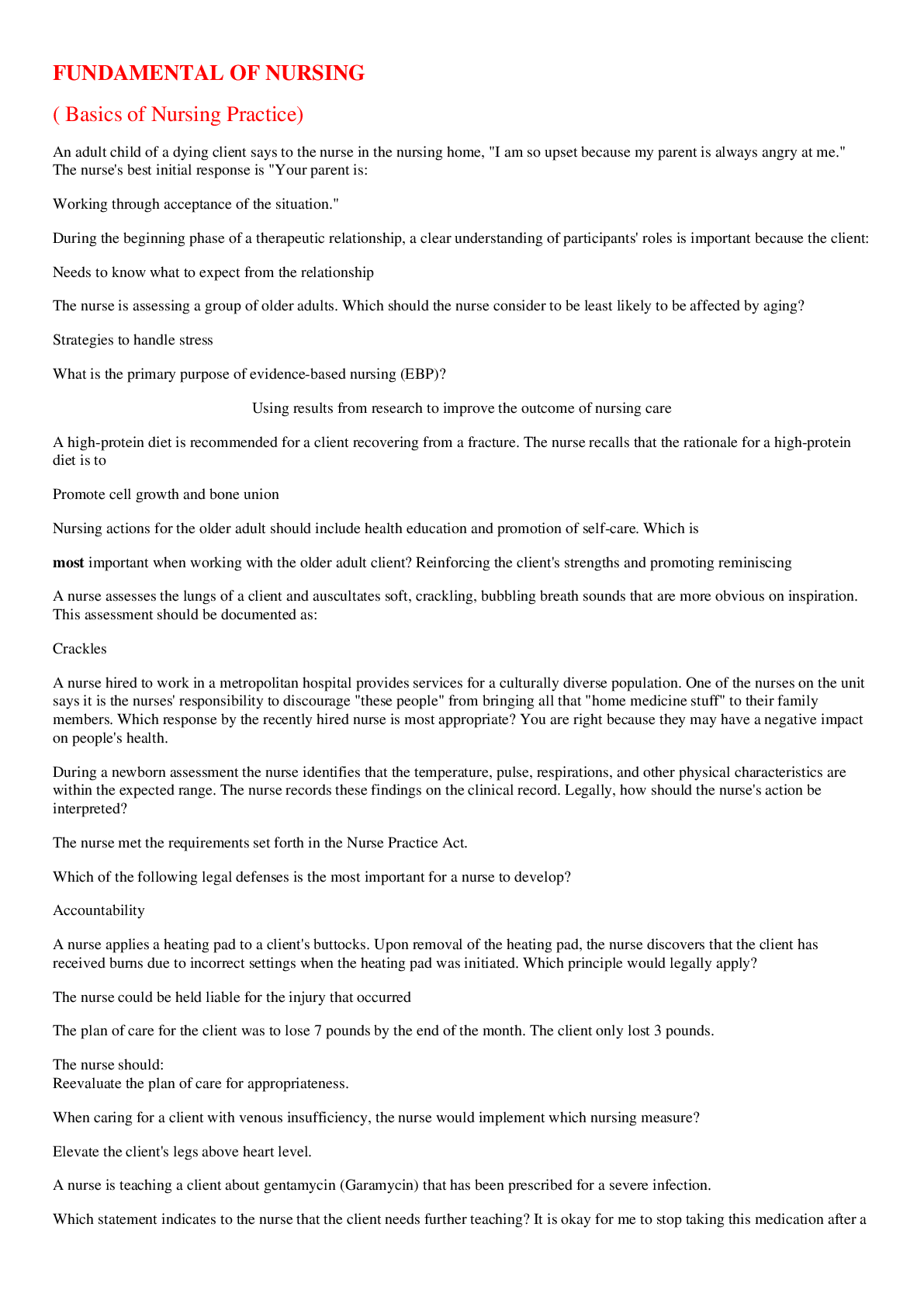
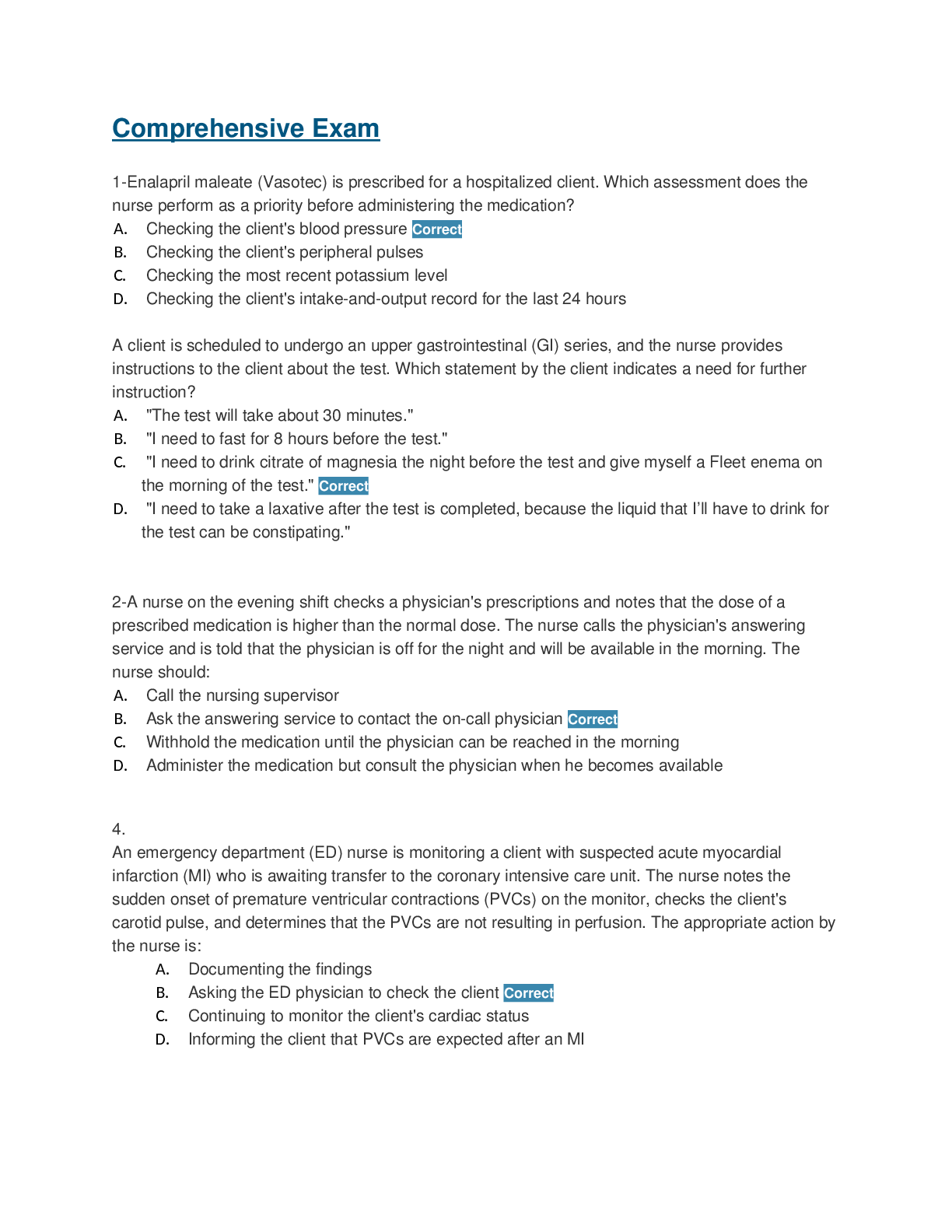
 Exam Guide Verified Questions and Answers.png)
 Verified Questions and Answers with Explanations Download to Score A.png)
